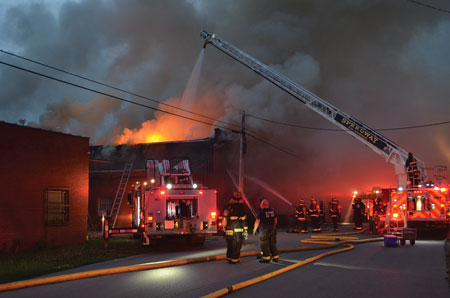
The fire department dispatching center receives a report of a fire in the industrial part of town. This happened in Indianapolis, Indiana, on a Thursday night at 2055 hours. In this area, after about 5:00 p.m. on weeknights and all weekend, the sidewalks are rolled up and not that many citizens are in the area. By the time the fire department gets the call indicating a fire, the building might have been burning for a long time. The units dispatched to this fire were dispatched to a chimney fire. On arrival, the first unit reported fire and smoke showing, indicating the fire had time to become more than an incipient-stage fire. Any delay in reporting a fire will allow fire development to increase. Call for help early if you think you might need it.
![(1) Aerial devices are positioned to allow for elevated master stream delivery. The locations of overhead wires have been taken into account, and the apparatus was moved or the overhead lines were deenergized. <i>[Photos courtesy of the Indianapolis (IN) Fire Department.] </i>](https://emberly.fireengineering.com/wp-content/uploads/2016/03/1603FEFF_1.jpg) |
| (1) Aerial devices are positioned to allow for elevated master stream delivery. The locations of overhead wires have been taken into account, and the apparatus was moved or the overhead lines were deenergized. [Photos courtesy of the Indianapolis (IN) Fire Department.] |
This building, two stories in height and of ordinary construction, had possible offices or other uses for the spaces on the second floor. This type of structure has been used in the past for all sorts of reasons: illegal social clubs and bars, storefront churches, dance halls, social halls, and other occupancies that allow the owner to get revenue from unused or underused spaces. The “Happy Land” social club in New York City comes to mind. The owner needs more money to cover the cost of the building, and the local community is looking for a place to gather. The space is cheaper than legal and licensed areas for bars and clubs. Plus the clubs or bars can be removed from the public eye, so people won’t report them.
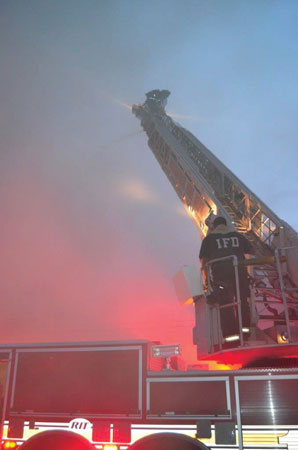 |
| (2) The firefighter on the tip of the ladder is directing the elevated master stream because the apparatus operator’s vision is obscured by the smoke conditions. |
This means that you must examine quickly the second floor of this type of structure if conditions permit. There might be an unforeseen life hazard, and the space might not be well marked to avoid detection. Local units responding to the area are critical to the discovery of such spaces before a major incident. At this fire, personnel quickly searched the second floor. The search proved negative; the space was determined to be offices.
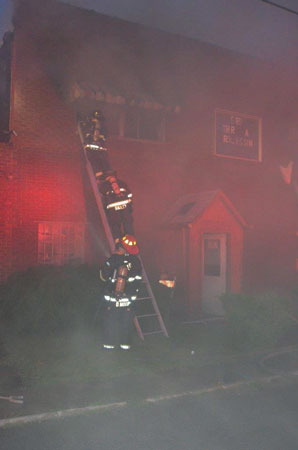 |
| (3) A member makes his way up a portable ladder to do a quick search of the second floor for possible victims. Another member will enter the room with him, and a third member will monitor conditions and stay at the window as an emergency contact. |
A thermal processing company was using the building to heat, treat, and clean aircraft parts. That indicated to the first-arriving chief that there might be some types of hazardous materials within the structure. These types of metal works companies can use large vats of acids, large vats of a basic substance, and hydrogen cyanide in their metal cleaning and treating processes. This information is vital to the first-arriving chief officer, who, depending on conditions, will call for a hazmat response if warranted.
 |
| (4) Members get a handline into position on the roof of a one-story setback to operate into the second floor. The fire originated in the second-floor roof space. |
At this fire, the incident commander (IC) had hazmat units respond for a possible spill; none was found. Officers and members of the hazmat unit can also provide information about materials used on site through their database. How to handle the material might be critical to operating units. It is important to know if the substances are water-reactive or flammable.
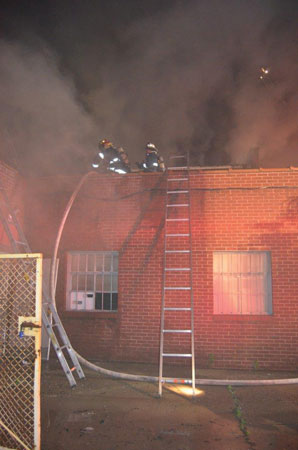 |
| (5) Members position a ladder for a quick escape from the roof of the one-story setback. The firefighters operating the line on the roof need a quick and safe way off the roof if conditions change. |
At this fire, first-due units made an interior attack, and members were sent to the roof to attempt roof ventilation and open up the roof to relieve the top floor of fire, smoke, and pent-up products of combustion. These roof operations were in progress for about 10 minutes when conditions began to worsen and the chief ordered members off the roof. When members are ordered off the roof because of deteriorating conditions, they should use the safest way off the roof-which may not always be the quickest way. Stay near the parapet where the beams are the strongest and offer the most support. Here, members made their way off the roof, and operations went defensive quickly.
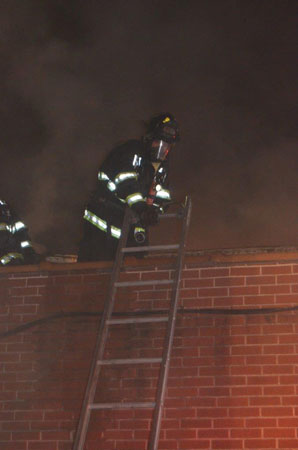 |
| (6) A member operating on the setback’s roof ensures that the ladder is secure. If members are moving the hoseline, someone needs to protect the ladder as the primary means of egress. |
The fire was deep-seated and had control of the second floor quickly. It was likely caused by a possible rekindle from an earlier small fire on the roof caused by a maintenance worker using a torch to seal the rubber roofing. It was deemed safe to apply water, and an exterior attack commenced. Three aerial devices and six handlines brought the fire under control. As with any fire that goes defensive, take into account any overhead wires when setting up the aerial devices. The IC positioned the devices to avoid some wires or had the local utility deenergize other wires to allow apparatus access. Crews brought the fire under control and secured the premises.
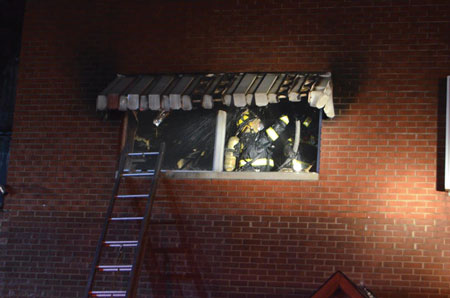 |
| (7) The fire is knocked down; members are overhauling the second floor to check for hot spots. A firefighter places a portable ladder to the second floor as an emergency egress point if necessary. |
Fires in commercial warehouse-type buildings can present a significant fire problem as well as unforeseen life hazards. Check and search these buildings as quickly as possible for life hazards. The other major issue is determining what is stored and used inside these buildings. Preplanning and advanced notice of the hazards are always in the best interest of responding fire units. If no information is available, size up the building and determine the fire attack strategy based on the available information. Also use the resources of the hazmat units, the building owners, and the tenants to make an informed decision.
MICHAEL M. DUGAN is a 27-year veteran of the Fire Department of New York, where he served as captain of Ladder Company 123 before retiring in 2012. As a lieutenant, he served in Ladder Company 42 and was a firefighter in Ladder Company 43. He has been involved with the fire service for 39 years.
What Would You Do? Warehouse Fire
Miami Warehouse Fire
Just Another Warehouse Fire? No Such Thing!
Fire Engineering Archives

